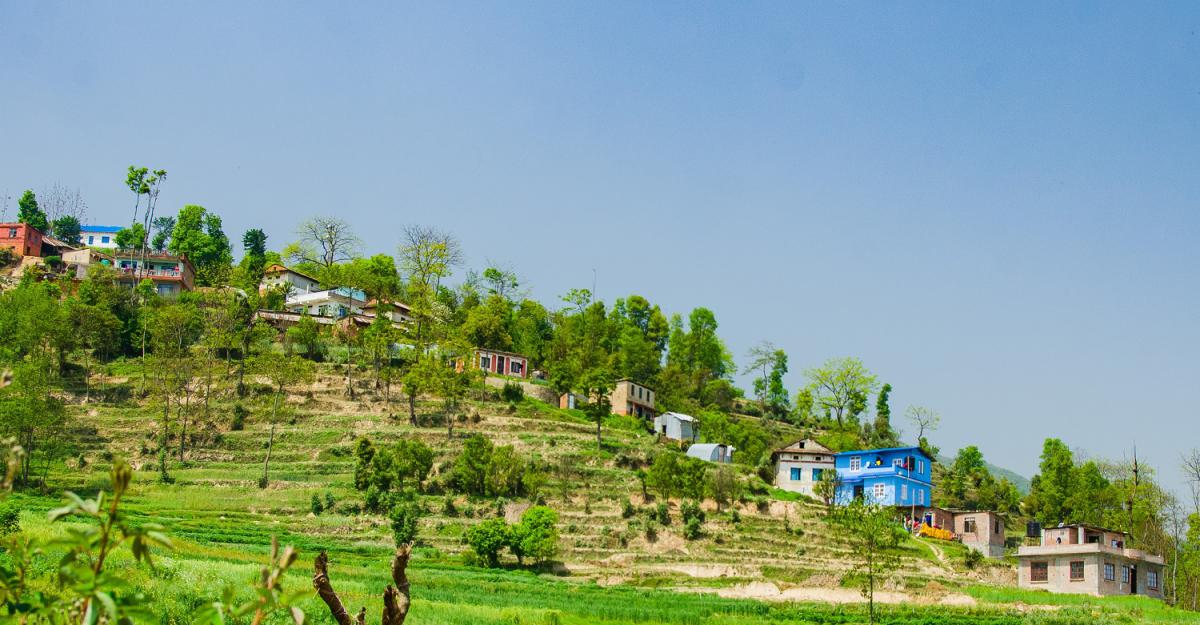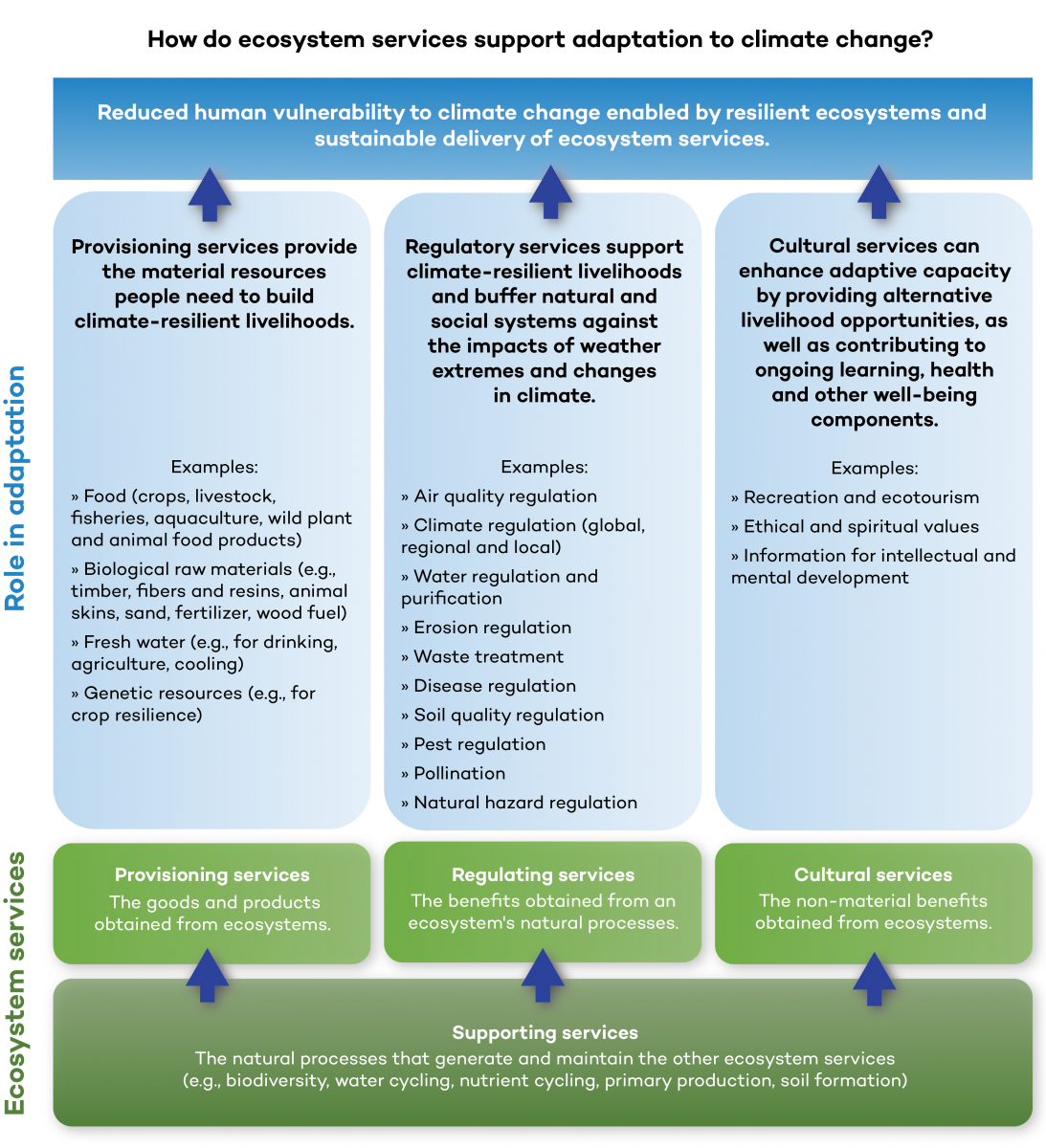Connecting the Dots: How ecosystem services support adaptation to climate change
What does Ecosystem-based Adaptation (EbA) look like in practice? This blog looks at lessons from recent work in Nepal.

Over the last few months, we have been giving a lot of thought to the role that ecosystems play in adaptation to climate change.
We know that healthy ecosystems are critical for sustaining livelihoods and building adaptive capacity, but what does Ecosystem-based Adaptation (EbA) look like in practice? And how can we equip people working in the fields of adaptation, conservation and development with the information and guidance they need to design, implement and monitor effective EbA options?
IISD is exploring these questions in collaboration with IUCN through the development of an EbA planning tool. We understand EbA to mean restoring, conserving and managing ecosystems in ways that increase people’s adaptive capacity while also building the resilience of the ecosystems themselves.
The new tool we are developing aims to provide practitioners with a systematic process to identify and prioritize EbA options based on a context-specific analysis of ecosystems, livelihoods and climate change.
EbA in Action: Testing the tool in Nepal

Recently, we had the opportunity to test our early thinking on the tool in the context of the Ecosystem-based Adaptation (EbA) in Mountain Ecosystems (EbA flagship) Project, recently implemented by IUCN in the Panchase Protected Forest Area of Western Nepal. Below is a working framework outlining the critical role that ecosystems play in climate change adaptation. It describes how each of the major categories of ecosystem services identified by the Millennium Ecosystem Assessment can support people in building climate-resilient livelihoods and increasing their adaptive capacity.
“The EbA planning tool is very effective as it takes a step-by-step approach. During the process we were able to understand and visualize what EbA is and why it is important for people, their livelihoods and nature. Particularly, the process of identifying and prioritizing EbA options is very useful, considering multiple criteria and multiple indicators, looking at livelihoods, ecosystems, opportunities, barriers and other factors in one process.” – Anu Adhikari, IUCN Nepal

In Nepal, more than three-quarters of the workforce engage in agriculture and therefore depend on climate-sensitive natural resources for their livelihoods. This means that climate change impacts on ecosystems—and the consequences for people and their livelihoods—are a fundamental consideration when thinking about climate change adaptation strategies. Considering the interlinkages means that ecosystem services are a good place to start when thinking about options for adaptation. In analyzing livelihoods, ecosystems and climate change in the Panchase region specifically, we found many examples that support this working framework:
- Provisioning services provide the raw materials for livelihoods in rural areas. In the Panchase region these include fuelwood, non-timber forest products, medicinal and aromatic plants, fodder, flowering plants and freshwater sources—all of which support essential livelihood activities. Our analysis found that conservation and sustainable management of these resources are critical to enable people to build climate-resilient livelihoods and to ensure the health and resilience of the local ecosystems over the longer term.
- Regulating services determine the quality and availability of provisioning services through natural processes. In the Panchase region, regulating services are provided by the protected and community forest, wetlands, lakes and ponds, rivers and cropland. Effective functioning of these regulating processes, despite climate change, is critical for the sustained supply of provisioning services and for buffering against climate risks. In Panchase, for example, a healthy, diverse forest plays a key role in stabilizing slopes and reducing erosion, which protects communities and their livelihoods from hazards such as storms and floods. Conserving the forest therefore protects the supply of the services that it provides to enable livelihoods adaptation, while also reducing risks associated with climate hazards.
- Cultural ecosystem services have a less direct link to adaptation; however, they are important to livelihoods as a considerable economic resource and often have very specific and important value to local people. In the Panchase region, ecotourism and homestays (renting rooms in one’s home to travellers) are helping local people diversify their livelihoods by providing a new source of income that is less dependent on climate-sensitive resources than, for example, agriculture.
- Supporting services, such as water cycling or soil formation, maintain the other services by providing the building blocks that underpin all other ecosystem services and determine the health and functionality of ecosystems. As demonstrated by the Panchase example, only healthy and well-functioning ecosystems can provide adaptation services, support livelihoods and enhance natural resilience to the adverse impacts of climate change. Supporting services are fundamental to ecosystem health and therefore must be sustained for EbA to occur.
Piloting the EbA planning tool with the IUCN Nepal team allowed us great insights about the practice of EbA and the challenges faced by practitioners in planning and implementing adaptation projects with an ecosystem focus, such as prioritizing effective EbA options and designing long-term monitoring and evaluation frameworks.
We are now applying what we learned to further refine and develop the EbA planning tool before our next pilot test. Working with those who will be using the tool is critical to ensure that it is as practical and useful as it can be. IISD is grateful to IUCN for the opportunity, and we look forward to our continued collaboration.
The project is funded by EbA South, a GEF-funded project implemented by UNEP and executed by the National Development and Reform Commission of China (NDRC) through the Institute of Geographic Sciences and Natural Resources Research, Chinese Academy of Sciences.
Photos above: Anika Terton

Pictured (left to right): Angie Dazé, Racchya Shah, Anu Adhikari, Amit Poudyal, Anika Terton
You might also be interested in
ALivE Adaptation, Livelihoods and Ecosystem Planning Tool: User Manual
The ALivE user manual provides detailed guidance on applying the computer-based ALivE tool designed to support the planning of effective and feasible ecosystem-based adaptation options.
Multilateral Development Bank Efforts to Mainstream Climate Adaptation
The paper explores the progress of four MDBs in mainstreaming climate adaptation in their developing country portfolios, specifically looking at experiences in Kenya, Nepal, and Peru.
Review of Current and Planned Adaptation Action in Nepal
This report summarizes the climate risks and vulnerable sectors in Nepal, providing an overview of policies and initiatives introduced at the national and sub-national levels to advance the country’s adaptation efforts.
Tree Planting for Climate Resilience in Freetown, Sierra Leone
This assessment presents the economic valuation of tree planting efforts in Freetown, Sierra Leone, including planting costs, added benefits, and avoided costs.
